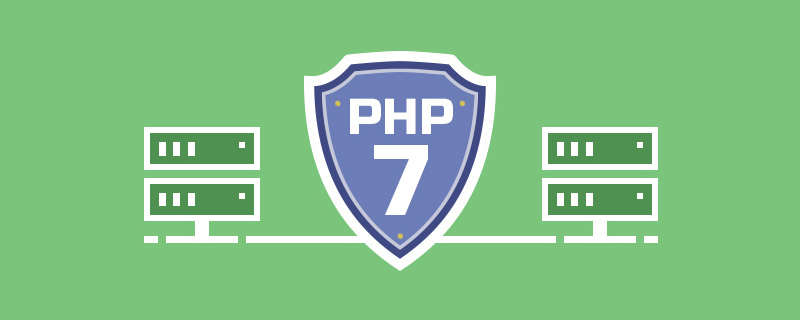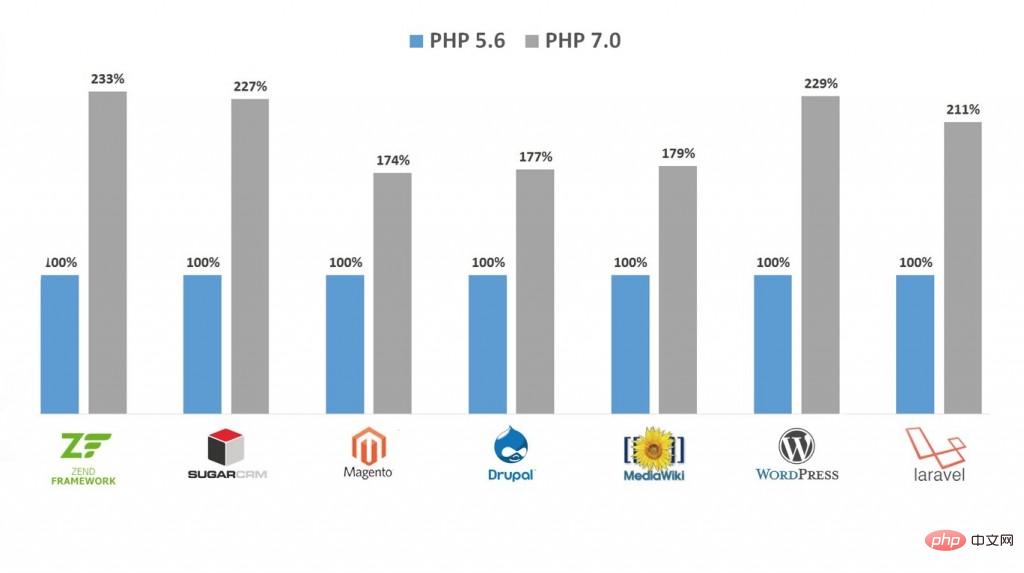 Backend Development
Backend Development
 PHP7
PHP7
 Introducing several settings for opening Opcache in PHP7 and optimizing PHP7 performance
Introducing several settings for opening Opcache in PHP7 and optimizing PHP7 performance
Introducing several settings for opening Opcache in PHP7 and optimizing PHP7 performance

PHP7 has been released. As the largest version upgrade and the largest performance upgrade of PHP in 10 years, PHP7 has shown obvious performance improvements in multiple tests. However, in order to make It can exert its maximum performance, but I still have a few things to remind you.

1. Opcache
Remember to enable it Zend Opcache, because PHP7 is faster even without Opcache enabled than PHP-5.6 with Opcache enabled, so some people did not enable Opcache during the previous testing period. Enabling Opcache is very simple, just add:# in the php.ini configuration file. ##zend_extension=opcache.soopcache.enable=1opcache.enable_cli=1"
2. Use a new compilerUse a newer compiler, GCC 4.8 or above is recommended, because only GCC 4.8 or above PHP can Global Register for opline and execute_data support will be enabled, which will bring about a 5% performance improvement (measured from the QPS perspective of Wordpres)
In fact, versions before GCC 4.8 also support it, but we found that there are bugs in its support , so it must be version 4.8 or above to enable this feature.
3. HugePage
My previous article also introduced: Hugepage to make your PHP7 faster, first in the system Turn on HugePages, and then turn on Opcache's huge_code_pages.
Take my CentOS 6.5 as an example, allocate 512 reserved huge page memory through:
$sudo sysctl vm.nr_hugepages=512
:
$ cat /proc/meminfo | grep HugeAnonHugePages: 106496 kBHugePages_Total: 512HugePages_Free: 504HugePages_Rsvd: 27HugePages_Surp: 0Hugepagesize: 2048 kB
Then Add:
opcache.huge_code_pages=1
In this way, PHP will use large memory pages to save its own text segment and huge memory allocation, reducing TLB misses and improving performance.
4. Opcache file cache
Enable Opcache File Cache (experimental). By enabling this, we can let Opcache cache the opcode cache into an external file. For some scripts, there will be obvious problems. Performance improvement.
Add:opcache.file_cache=/tmp
to php.ini so that PHP will cache some Opcode binary export files in the /tmp directory, which can exist across the PHP life cycle.
5、PGO
我之前的文章: 让你的PHP7更快(GCC PGO) 也介绍过, 如果你的PHP是专门为一个项目服务, 比如只是为你的Wordpress, 或者drupal, 或者其他什么, 那么你就可以尝试通过PGO, 来提升PHP, 专门为你的这个项目提高性能.
具体的, 以wordpress 4.1为优化场景.. 首先在编译PHP的时候首先:
$ make prof-gen
然后用你的项目训练PHP, 比如对于Wordpress:
$ sapi/cgi/php-cgi -T 100 /home/huixinchen/local/www/htdocs/wordpress/index.php >/dev/null
也就是让php-cgi跑100遍wordpress的首页, 从而生成一些在这个过程中的profile信息.
最后:
$ make prof-clean$ make prof-use && make install
这个时候你编译得到的PHP7就是为你的项目量身打造的最高性能的编译版本.
暂时就这么多吧, 以后想起来再加, 欢迎大家尝试, thanks
更多免费推荐:PHP7教程
The above is the detailed content of Introducing several settings for opening Opcache in PHP7 and optimizing PHP7 performance. For more information, please follow other related articles on the PHP Chinese website!

Hot AI Tools

Undresser.AI Undress
AI-powered app for creating realistic nude photos

AI Clothes Remover
Online AI tool for removing clothes from photos.

Undress AI Tool
Undress images for free

Clothoff.io
AI clothes remover

Video Face Swap
Swap faces in any video effortlessly with our completely free AI face swap tool!

Hot Article

Hot Tools

Notepad++7.3.1
Easy-to-use and free code editor

SublimeText3 Chinese version
Chinese version, very easy to use

Zend Studio 13.0.1
Powerful PHP integrated development environment

Dreamweaver CS6
Visual web development tools

SublimeText3 Mac version
God-level code editing software (SublimeText3)

Hot Topics
 1664
1664
 14
14
 1422
1422
 52
52
 1316
1316
 25
25
 1268
1268
 29
29
 1240
1240
 24
24
 An article explaining the principle and use of PHP opcache in detail
Mar 22, 2023 pm 04:18 PM
An article explaining the principle and use of PHP opcache in detail
Mar 22, 2023 pm 04:18 PM
This article brings you relevant knowledge about PHP opcache. It mainly talks about how to understand the OPCache function and how to use it. Friends who are interested can take a look below. I hope it will be helpful to everyone.
 How to install opcache in centos php
Jan 19, 2023 am 09:50 AM
How to install opcache in centos php
Jan 19, 2023 am 09:50 AM
How to install opcache in centos php: 1. Execute the "yum list php73* | grep opcache" command; 2. Install opcache through "yum install php73-php-opcache.x86_64"; 3. Use "find / -name opcache.so" Just find the location of "opcache.so" and move it to php's extension directory.
 What should I do if the plug-in is installed in php7.0 but it still shows that it is not installed?
Apr 02, 2024 pm 07:39 PM
What should I do if the plug-in is installed in php7.0 but it still shows that it is not installed?
Apr 02, 2024 pm 07:39 PM
To resolve the plugin not showing installed issue in PHP 7.0: Check the plugin configuration and enable the plugin. Restart PHP to apply configuration changes. Check the plugin file permissions to make sure they are correct. Install missing dependencies to ensure the plugin functions properly. If all other steps fail, rebuild PHP. Other possible causes include incompatible plugin versions, loading the wrong version, or PHP configuration issues.
 How to install mongo extension in php7.0
Nov 21, 2022 am 10:25 AM
How to install mongo extension in php7.0
Nov 21, 2022 am 10:25 AM
How to install the mongo extension in php7.0: 1. Create the mongodb user group and user; 2. Download the mongodb source code package and place the source code package in the "/usr/local/src/" directory; 3. Enter "src/" directory; 4. Unzip the source code package; 5. Create the mongodb file directory; 6. Copy the files to the "mongodb/" directory; 7. Create the mongodb configuration file and modify the configuration.
 How to solve the problem when php7 detects that the tcp port is not working
Mar 22, 2023 am 09:30 AM
How to solve the problem when php7 detects that the tcp port is not working
Mar 22, 2023 am 09:30 AM
In php5, we can use the fsockopen() function to detect the TCP port. This function can be used to open a network connection and perform some network communication. But in php7, the fsockopen() function may encounter some problems, such as being unable to open the port, unable to connect to the server, etc. In order to solve this problem, we can use the socket_create() function and socket_connect() function to detect the TCP port.
 PHP Server Environment FAQ Guide: Quickly Solve Common Problems
Apr 09, 2024 pm 01:33 PM
PHP Server Environment FAQ Guide: Quickly Solve Common Problems
Apr 09, 2024 pm 01:33 PM
Common solutions for PHP server environments include ensuring that the correct PHP version is installed and that relevant files have been copied to the module directory. Disable SELinux temporarily or permanently. Check and configure PHP.ini to ensure that necessary extensions have been added and set up correctly. Start or restart the PHP-FPM service. Check the DNS settings for resolution issues.
 How to automatically set permissions of unixsocket after system restart?
Mar 31, 2025 pm 11:54 PM
How to automatically set permissions of unixsocket after system restart?
Mar 31, 2025 pm 11:54 PM
How to automatically set the permissions of unixsocket after the system restarts. Every time the system restarts, we need to execute the following command to modify the permissions of unixsocket: sudo...
 How to install and deploy php7.0
Nov 30, 2022 am 09:56 AM
How to install and deploy php7.0
Nov 30, 2022 am 09:56 AM
How to install and deploy php7.0: 1. Go to the PHP official website to download the installation version corresponding to the local system; 2. Extract the downloaded zip file to the specified directory; 3. Open the command line window and go to the "E:\php7" directory Just run the "php -v" command.



